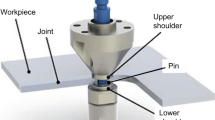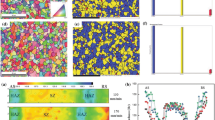Abstract
Friction stir back extrusion (FSBE) is used to produce brass wires, and then numerical modeling is developed to model the process by the coupled Eulerian-Lagrangian (CEL) technique and verified by experiments. Next, the effects of FSBE parameters, including tool rotational and plunging speed, on the strain and temperature distributions, microstructure, and material flow patterns are studied. The results show that the highest temperature and strain occur near the tool/workpiece interface but at a further distance from the tool axis. Additionally, in the cross section of an FSBE wire, the microstructure is more refined in the sample’s periphery. A higher rotational speed or a lower plunging speed results in a coarser microstructure. The material flow pattern is a conical helix and does not change meaningfully by the process parameters. The points at the further distance from the tool axis, along with an upward movement, experience an inward spiral motion which is amplified by higher rotational speed. However, the materials near the tool axis almost take an upward movement and endure a significantly lower strain.















Similar content being viewed by others
Data availability
All of the required experimental data for reproduction of these findings are explained with details in the section “Experimental procedure.”
The general data for the reproduction of the proposed simulation model are described in the section “Model description”; however, some minor details cannot be shared at this time as the data also form part of an ongoing study.
References
Heidarzadeh A (2019) Tensile behavior, microstructure, and substructure of the friction stir welded 70/30 brass joints: RSM, EBSD, and TEM study. Arch Civ Mech Eng 19(1):137–146
Igelegbai EE, Alo OA, Adeodu AO, Daniyan IA (2017) Evaluation of mechanical and microstructural properties of <i>α</i>-brass alloy produced from scrap copper and zinc metal through sand casting process. J Miner Mater Charact Eng 05(01):18–28
Heidarzadeh A, Laleh HM, Gerami H, Hosseinpour P, Shabestari MJ, Bahari R (2018) The origin of different microstructural and strengthening mechanisms of copper and brass in their dissimilar friction stir welded joint. Mater Sci Eng A 735(May):336–342
Heidarzadeh A, Barenji RV, Khalili V, Güleryüz G (2019) Optimizing the friction stir welding of the α/β brass plates to obtain the highest strength and elongation. Vacuum 159:152–160
Galai M et al (2017) α-Brass and (α + β) brass degradation processes in Azrou soil medium used in plumbing devices. Journal of Bio- and Tribo-Corrosion 3:30
Zhai Advisor Q, Yuan C Recycling metal chips from manufacturing industry through a combined hydrodynamic and electromagnetic separation approach Student Project Report. no. May, 2012.
Karadag HB, Bahtli T, Kara M (2016) The recycling of steel and brass chips to produce composite materials via cold pressing and sintering. Int J Eng Sci 5(5):1–6
Güleryüz G (Aug. 2020) Relationship between FSW parameters and hardness of the ferritic steel joints: modeling and optimization. Vacuum 178:109449
Yazdipour A, Heidarzadeh A (2016) Effect of friction stir welding on microstructure and mechanical properties of dissimilar Al 5083-H321 and 316L stainless steel alloy joints. J Alloys Compd 680:595–603
Akbari M, Asadi P (2020) Dissimilar friction stir lap welding of aluminum to brass: modeling of material mixing using coupled Eulerian–Lagrangian method with experimental verifications. Proc Inst Mech Eng L J Mater Des Appl 234(8):1117–1128
Mirzaei MH, Asadi P, Fazli A (2020) Effect of tool pin profile on material flow in double shoulder friction stir welding of AZ91 magnesium alloy. Int J Mech Sci 183(December 2019):105775
Abu-Farha F (2012) A preliminary study on the feasibility of friction stir back extrusion. Scr Mater 66(9):615–618
Dinaharan I, Sathiskumar R, Vijay SJ, Murugan N (2014) Microstructural characterization of pure copper tubes produced by a novel method friction stir back extrusion. Procedia Mater Sci 5:1502–1508
Mathew N, Dinaharan I, Vijay SJ, Murugan N (2016) Microstructure and mechanical characterization of aluminum seamless tubes produced by friction stir back extrusion. Trans Indian Inst Metals 69(10):1811–1818
Zhang S, Frederick A, Wang Y, Eller M, McGinn P, Hu A, Feng Z (2019) Microstructure evolution and mechanical property characterization of 6063 aluminum alloy tubes processed with friction stir back extrusion. Jom 71(12):4436–4444
Behnagh RA et al (2016) Experimental analysis and microstructure modeling of friction stir extrusion of magnesium chips. J Manuf Sci Eng Trans ASME 138(4):1–11
Baffari D, Buffa G, Campanella D, Fratini L, Reynolds AP (2017) Process mechanics in friction stir extrusion of magnesium alloys chips through experiments and numerical simulation. J Manuf Process 29:41–49
Baffari D, Buffa G, Fratini L (2017) A numerical model for wire integrity prediction in friction stir extrusion of magnesium alloys. J Mater Process Technol 247:1–10
Akbari M, Asadi P, Behnagh RA (Mar. 2021) Modeling of material flow in dissimilar friction stir lap welding of aluminum and brass using coupled Eulerian and Lagrangian method. Int J Adv Manuf Technol 113(3–4):721–734
Meyghani B, Awang MB, Emamian SS, Mohd Nor MKB, Pedapati SR (2017) A comparison of different finite element methods in the thermal analysis of friction stir welding (FSW). Metals (Basel) 7:450
Assidi M, Fourment L, Guerdoux S, Nelson T (2010) Friction model for friction stir welding process simulation: calibrations from welding experiments. Int J Mach Tools Manuf 50(2):143–155
Ansari MA, Samanta A, Behnagh RA, Ding H (2019) An efficient coupled Eulerian-Lagrangian finite element model for friction stir processing. Int J Adv Manuf Technol 101(5–8):1495–1508
Dinaharan I, Zhang S, Chen G, Shi Q (Jan. 2020) Titanium particulate reinforced AZ31 magnesium matrix composites with improved ductility prepared using friction stir processing. Mater Sci Eng A 772:138793
Dinaharan I, Thirunavukkarasu R, Murugan N, Akinlabi ET (2019) Microstructure evolution and tensile behavior of dissimilar friction stir-welded pure copper and dual-phase brass. Metallogr Microstruct Anal 8(5):735–748
Akbari M, Asadi P, Givi MB, Zolghadr P (2016) A cellular automaton model for microstructural simulation of friction stir welded AZ91 magnesium alloy. Model Simul Mater Sci Eng 24:035012
Asadi P, AkbariM, Karimi-Nemch H (2014) Simulation of friction stir welding and processing, in Advances in Friction-Stir Welding and Processing. In: Givi MKB, Asadi P Editors. Woodhead Publishing, pp 499–542
Tayebi P, Fazli A, Asadi P, Soltanpour M (2019) Formability analysis of dissimilar friction stir welded AA 6061 and AA 5083 blanks by SPIF process. CIRP J Manuf Sci Technol 25:50–68
Forsström A, Bossuyt S, Yagodzinskyy Y, Tsuzaki K, Hänninen H (2019) Strain localization in copper canister FSW welds for spent nuclear fuel disposal. J Nucl Mater 523:347–359
Asadi P, Besharati Givi MK, Akbari M (2015) Microstructural simulation of friction stir welding using a cellular automaton method: a microstructure prediction of AZ91 magnesium alloy. Int J Mech Mater Eng 10(1):20
Fratini L, Buffa G, Lo Monaco L (2010) Improved FE model for simulation of friction stir welding of different materials. Sci Technol Weld Join 15(3):199–207
Heidarzadeh A, Kazemi-Choobi K, Hanifian H, Asadi P (2014) Microstructural evolution. In: Givi MKB, Asadi P (eds.) Advances in Friction-Stir Welding and Processing. Woodhead Publishing pp, 65–140
Li G et al (2019) Effect of self-reacting friction stir welding on microstructure and mechanical properties of Mg-Al-Zn alloy joints. J Manuf Process 37(July 2018):1–10
Zhang J et al (2020) Optimizing the mechanical properties of friction stir welded dissimilar joint of AM60 and AZ31 alloys by controlling deformation behavior. Mater Sci Eng A 773:138839
Author information
Authors and Affiliations
Contributions
All the authors have participated in the conception, design, analysis, and interpretation of the data as well as the writing, drafting, and revising of the article.
Corresponding author
Ethics declarations
Ethics approval
Since the study is performed on the metallic samples, there is no need for ethical approval; however, all the tests are done in Imam Khomeini International University, in the metal forming, material processing, and SEM Labs under the control of trained experts. Additionally, the paper’s primary data is not published elsewhere.
Consent to participate
All the authors declare that they have agreed to authorship, have read and approved the manuscript, and have given consent for submission and subsequent publication.
Competing interests
The authors declare no competing interests.
Additional information
Publisher’s note
Springer Nature remains neutral with regard to jurisdictional claims in published maps and institutional affiliations.
Rights and permissions
About this article
Cite this article
Asadi, P., Akbari, M. Numerical modeling and experimental investigation of brass wire forming by friction stir back extrusion. Int J Adv Manuf Technol 116, 3231–3245 (2021). https://doi.org/10.1007/s00170-021-07729-5
Received:
Accepted:
Published:
Issue Date:
DOI: https://doi.org/10.1007/s00170-021-07729-5




